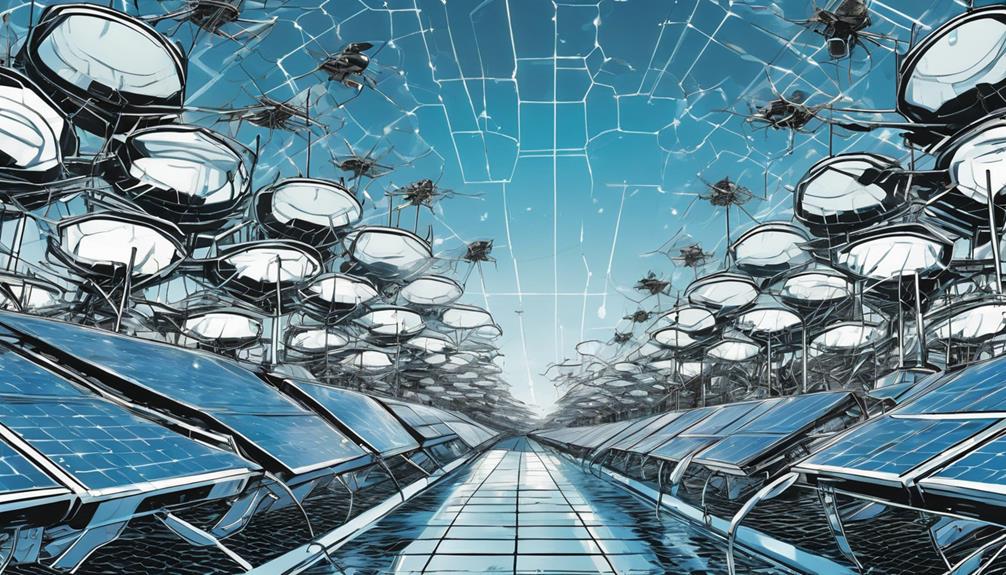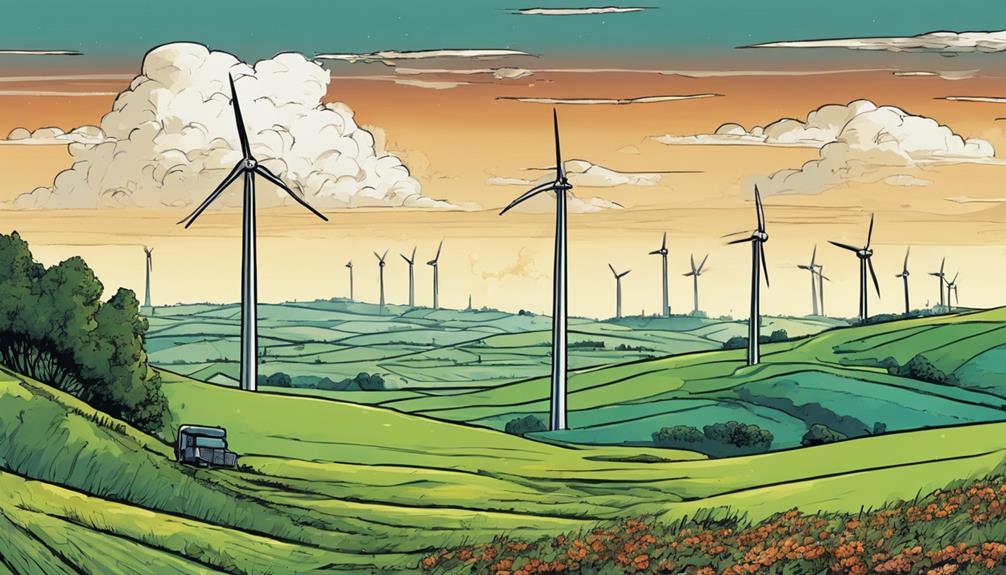As we shift towards solar energy, we need to account for its impact on land and water. We're reducing our environmental footprint by minimizing greenhouse gas emissions, water usage, and air pollution. However, we must carefully manage land use to avoid negative impacts on agriculture and optimize space usage. We're also adopting water-conserving practices and mitigating land degradation. But we need to assess the effects on aquatic ecosystems and promote sustainable development practices. As we explore solar energy's benefits, we'll uncover more about its intricate relationship with land and water, and how we can strike a balance between energy production and environmental stewardship.
Key Takeaways
- Solar energy minimizes environmental footprint by reducing greenhouse gas emissions, water usage, and air pollution.
- Careful land management strategies optimize space usage, avoiding negative impacts on agriculture and ensuring sustainable practices.
- Water conservation strategies, such as adoption of water-efficient technologies and reduction of water waste, are implemented in manufacturing.
- Land degradation mitigation strategies, including restoration of degraded land and prevention of desertification, promote long-term sustainability.
- Evaluation of impacts on aquatic ecosystems, including creation of artificial habitats and minimization of risks, informs proper site selection and design.
Minimizing Environmental Footprint

As we move towards renewable energy sources, we're finding that solar energy stands out for its impressive ability to minimize our environmental footprint, drastically reducing greenhouse gas emissions and water usage in the process. This clean energy source produces no air pollution, making it an appealing alternative to traditional energy forms.
What's more, solar energy requires minimal water usage, conserving this valuable resource. By shifting to solar energy, we're greatly reducing air pollution from traditional sources, supporting sustainable water management, and creating a healthier environment.
With careful planning, we can make sure that solar energy development complements our natural ecosystems, rather than harming them.
Land Use and Management
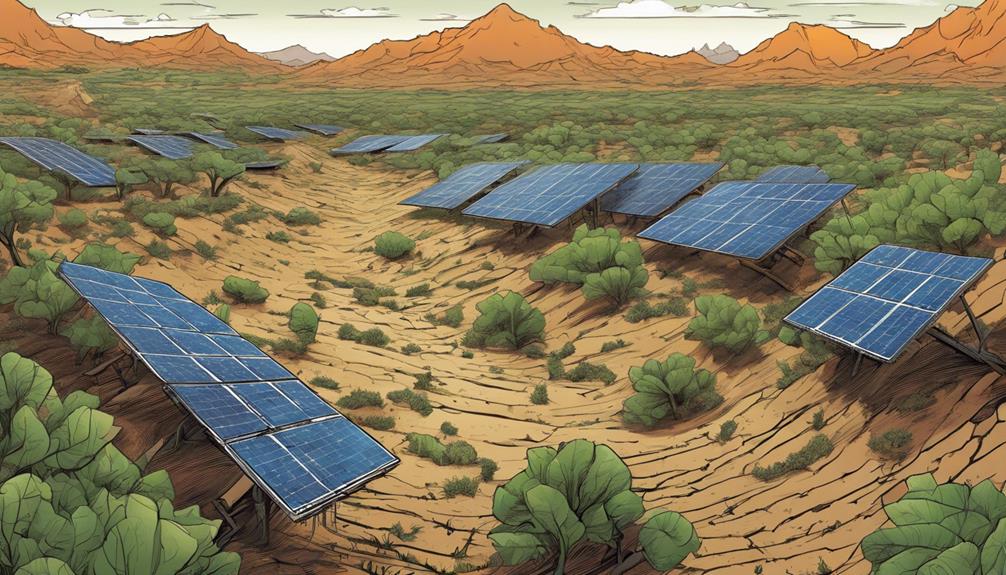
We must carefully manage land use for solar energy installations to avoid negative impacts on agriculture and soil erosion. As we shift to renewable energy, it's vital to take into account the land requirements for solar panels. We need to make sure that agricultural practices aren't compromised and soil fertility isn't affected.
Efficient land management strategies are essential to optimize space usage. We can rehabilitate degraded land to make it suitable for solar power installations, and proper planning can even positively impact soil fertility by providing shade and reducing erosion.
Water Conservation Strategies

By adopting water-conserving practices in the manufacturing process, we can greatly reduce the strain on water resources and support sustainable water management in regions where solar energy is produced. This is pivotal, as solar power manufacturing requires water, and conserving it's essential.
Here are some strategies we can implement:
- Implementing water-efficient technologies in manufacturing facilities
- Reducing water waste through recycling and reuse
- Sourcing materials from suppliers that adhere to water-conserving practices
- Conducting regular water audits to identify areas for improvement
- Investing in research and development of water-free manufacturing processes
Land Degradation Mitigation
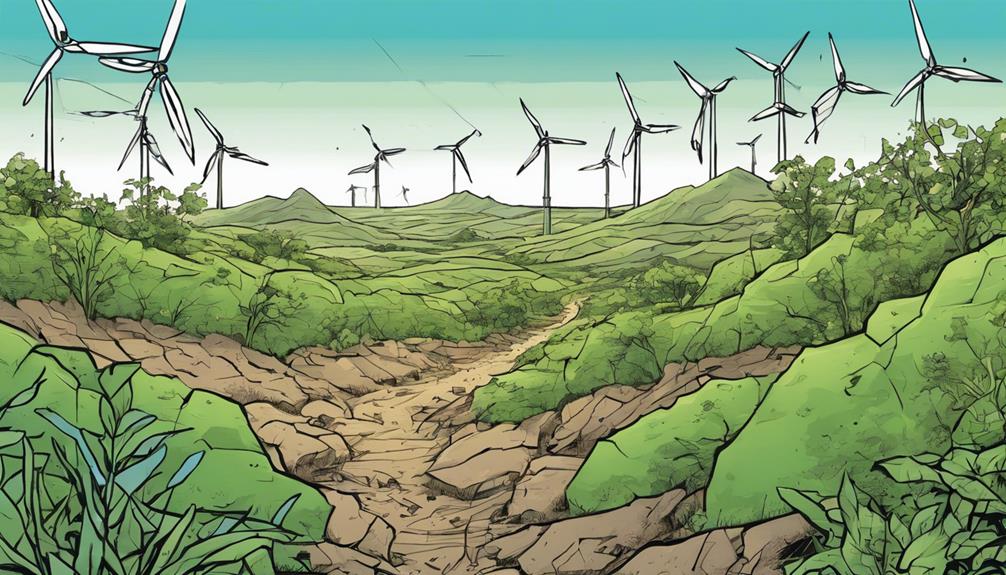
We're examining land degradation mitigation strategies, which are vital for securing the long-term sustainability of solar energy projects and the ecosystems they inhabit.
Restoring degraded land can create favorable conditions for solar power installations, and implementing measures to prevent desertification safeguards solar energy infrastructure.
Proper land management minimizes adverse effects of solar energy development, and sustainable land use planning is essential for the long-term sustainability of land and renewable energy projects.
We must prioritize land degradation mitigation to guarantee the efficiency and effectiveness of solar energy projects. By doing so, we can promote sustainable development and safeguard the environment for future generations.
Aquatic Ecosystem Impacts

How do solar panels installed in or near water bodies impact aquatic ecosystems, and what measures can be taken to mitigate any negative effects?
As we explore the integration of solar energy into our environment, it's crucial to evaluate the potential impacts on aquatic ecosystems. While solar panels can provide a renewable source of energy, their installation in water bodies can alter the habitat and affect the biodiversity of aquatic species.
- Solar panels can create artificial habitats, supporting the growth of aquatic plants and providing shelter for fish.
- However, they can also block sunlight, reducing photosynthesis and affecting the food chain.
- Changes in water temperature and shading effects must be carefully assessed.
Proper site selection and design can minimize the risks to aquatic ecosystems. By taking these factors into consideration, we can ensure that solar energy production coexists with the preservation of aquatic ecosystems.
Sustainable Development Practices
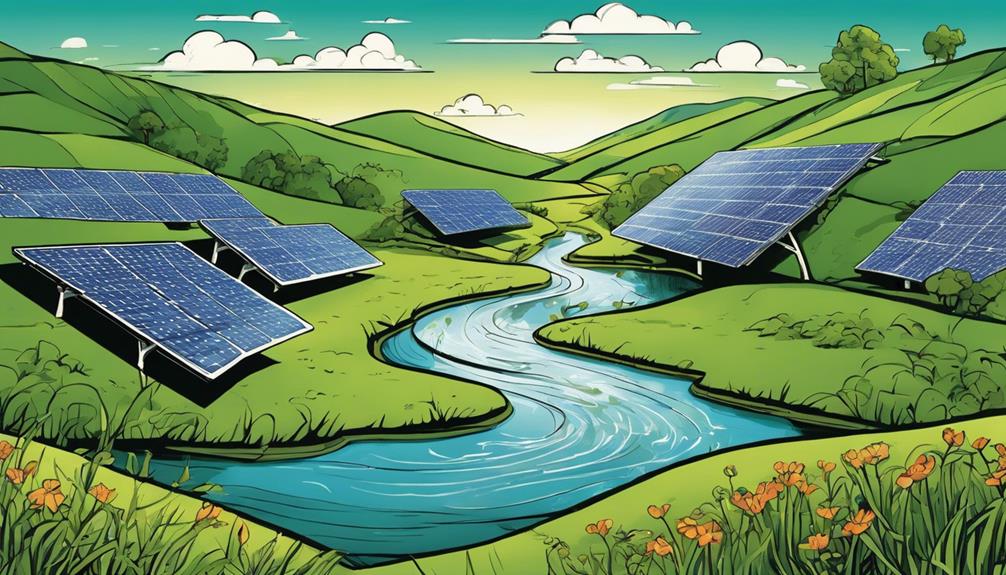
As we push for a renewable energy future, integrating sustainable development practices into solar energy projects is vital to minimizing environmental impacts and guaranteeing long-term viability.
We must adopt a holistic approach that considers the entire project lifecycle, from planning to decommissioning. This includes conducting thorough environmental impact assessments, engaging with local communities, and implementing measures to mitigate potential negative effects.
By doing so, we can ensure that solar energy projects not only reduce greenhouse gas emissions but also promote sustainable land use, conserve water resources, and support biodiversity.
It's essential that we prioritize sustainable development practices to create a renewable energy future that benefits both people and the planet.
Environmental Benefits Analysis

By moving towards solar energy, we greatly decrease our carbon footprint, mitigating the devastating effects of climate change and promoting a healthier environment for future generations.
This shift has numerous environmental benefits, including:
- Decreasing greenhouse gas emissions and air pollution from traditional energy sources
- Minimizing water usage, conserving this valuable resource for other essential purposes
- Supporting sustainable land use by utilizing degraded or underutilized land for solar installations
- Preventing soil erosion and enhancing soil fertility through shade provided by solar panels
- Preserving water resources by reducing evaporation rates in water bodies with solar panels installed above them
Frequently Asked Questions
Can Solar Energy Be Used to Power Water Treatment Plants?
"We're exploring if solar energy can power water treatment plants, and the answer is yes As a renewable source, solar energy can efficiently power treatment plants, reducing reliance on traditional energy sources."
How Does Solar Energy Impact Local Food Systems and Agriculture?
'As we sow the seeds of solar energy, we must guarantee they don't wither our local food systems. Solar panels can be a double-edged sword, affecting crop growth and agricultural practices, but careful planning can help us harvest the benefits.'
Are There Any Solar Energy Technologies That Don't Require Land Occupation?
We're exploring alternatives to land-based solar energy, and yes, there are options that don't require land occupation. For instance, floating solar panels on water bodies can generate power while conserving land.
Can Solar Energy Help in Preventing Natural Disasters Like Floods and Droughts?
"Oh, we're just gonna magically prevent floods and droughts with solar energy? Please. But seriously, by reducing evaporation rates and conserving water resources, solar energy can indeed help mitigate the severity of these natural disasters."
Are There Any International Agreements Governing Solar Energy's Impact on Land and Water?
"We're exploring international agreements governing solar energy's impact on land and water. While there aren't specific treaties, agreements like the Paris Agreement and UN's Sustainable Development Goals indirectly address these concerns."
How Does Earth’s Atmosphere Impact the Absorption of Solar Energy on Land and Water?
The impact of solar energy absorption on Earth’s atmosphere is significant, affecting the distribution of heat on land and water. The atmosphere plays a crucial role in regulating the amount of solar energy that reaches the Earth’s surface, determining temperature patterns and influencing weather systems.
Conclusion
As we stand at the crossroads of solar energy's promise and its environmental complexities, we're reminded that the path to a sustainable future is paved with intention.
Like a sunflower that follows the sun, we must deliberately face the trade-offs and opportunities that come with harnessing solar power.
By doing so, we can illuminate a brighter tomorrow, where land and water are cherished, and the beauty of our planet is forever preserved.

